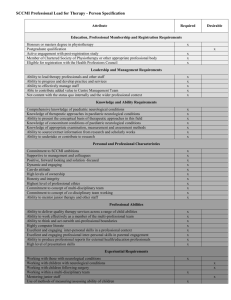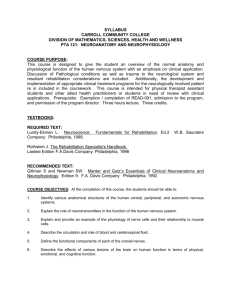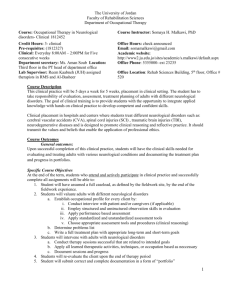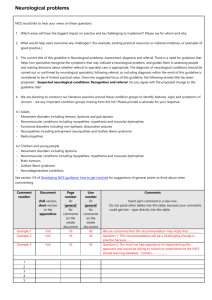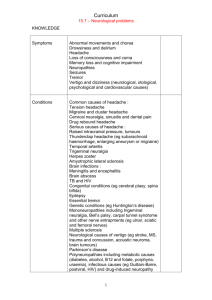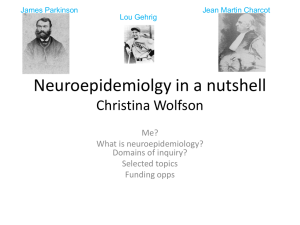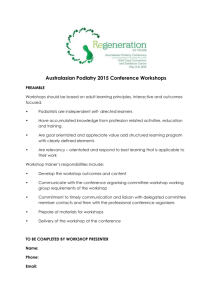Neuro numbers - Neurological Alliance
advertisement
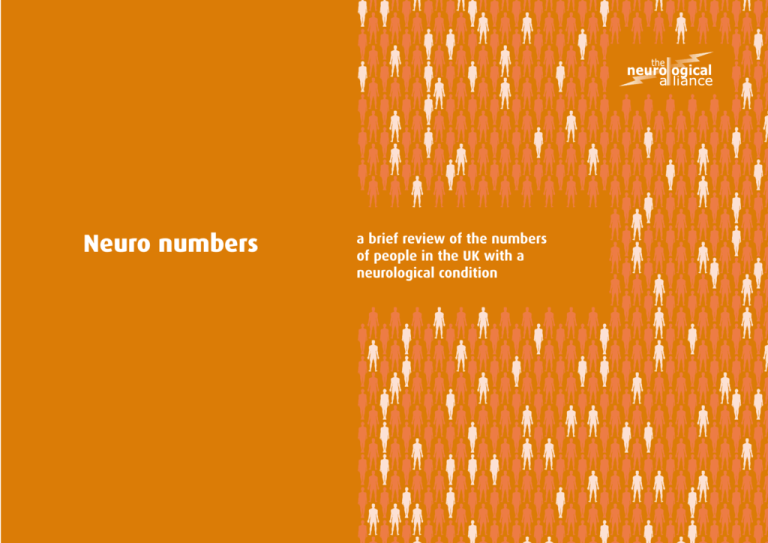
Neuro numbers a brief review of the numbers of people in the UK with a neurological condition There are 10 million people in the UK living with a neurological condition which has a significant impact on their lives Approximately 350,000 people (0.6% of the UK population) require help for most of their daily activities Of the 10 million people living with a neurological condition: Over one million people (2% of the UK population) are disabled by their neurological condition 3 Over eight million people are affected by a neurological condition, but are able to manage their lives on a day-to-day basis Who can be affected and what difficulties can they experience? 10,000,000 4 Neurological conditions affect all ages and people may experience the onset of a neurological condition at any time in their lives. There is increased prevalence of neurological conditions in older people as some conditions particularly affect older people and others are life long conditions. The numbers of people with neurological conditions will grow sharply in the next two decades due to improved survival rates, improved general health care and infection control, increased longevity and improved diagnostic techniques. People with neurological conditions can experience difficulties ranging from living with a condition which may weaken or disable them for periods of time through to needing help for most everyday tasks. Approximately 350,000 people require help for most of their daily activities Over one million people are disabled by their neurological condition Over eight million people are affected by a neurological condition, but are able to manage their lives on a dayto-day basis 350,000 1,000,000+ 8,000,000+ This will include most people with motor neurone disease (MND), many of those with primary and secondary progressive multiple sclerosis (MS) and other progressive neurodegenerative conditions, those with severe brain injuries, people who have had a serious stroke (including brain haemorrhage) or those who have advanced dementia. They may need help with some daily tasks and are likely to be out of full time employment. This figure includes most people with congenital conditions, such as cerebral palsy, those who have recently had a brain injury or illness, those who have had a stroke, some people living with MND, MS, Parkinson’s disease and forms of dementia. It also includes some of those with epilepsy or migraine. This figure includes a number of people living with MS, Parkinson’s disease and many more rarely diagnosed conditions, people recovering from stroke or head injury, people with essential tremor and other motor difficulties. It also includes many people living with migraine and chronic tension-type headache and many of those managing their epilepsy. Many of the people affected in this way will already have experienced an acute phase of their illness and often live with pain, the side effects of medication and the possibility that their condition could worsen, in some cases catastrophically or fatally, at any time. They will often need to adapt their lifestyle which can have an adverse effect on their quality of life. Though these people will often be in employment and with caring responsibilities of their own, there will be periods of time when they may need to be cared for or require help to carry out their daily activities; when they are unable to work or to carry out their lives to the full. 5 Neurological conditions are the most common cause of serious disability and have a major, but often unrecognised, impact on health and social services 6 1% 10% 17% 19% Each year 600,000 people (1% of the UK population) are newly diagnosed with a neurological condition 10% of visits to Accident and Emergency Departments are for a neurological problem 17% of GP consultations are for neurological symptoms 19% of hospital admissions are for a neurological problem requiring treatment from a neurologist or neurosurgeon Mostly stroke, epilepsy, dementia, headache, head injury and MS. There is little systematic collection of data on the numbers of people with neurological conditions in the UK. It is likely that these figures, being based on verifiable data, are an underestimate and show merely the tip of the iceberg. There is an urgent need for systematic collection of data, and further research into the needs of people living with neurological conditions. 30% 25% 33% Each year 200,000 children have an acquired brain injury About one quarter of people aged between 16 and 64 with chronic disability have a neurological condition Approximately one third of disabled people living in residential care have a neurological condition Approximately 850,000 people in the UK care for someone with a neurological condition However, most neurologically disabled people are not in residential care, but live at home, usually cared for by relatives. Carers often have to sacrifice their own work or leisure time. For example, family caregivers provide on average between five and 12 hours of care per day to people with moderate and severe MS. 30% of the people attending accident and emergency departments for head injury are children of 15 years and under Partners caring for someone with Parkinson’s disease are 40% less likely to get out of the house at least once a week or to take a holiday than their peers. Carers’ health is often compromised – about half suffer physical injuries such as a strained back and half experience stress-related illness. Carers may be all ages. Whilst many carers are elderly, a significant number of children and young people are carers of people with neurological conditions. 7 Incidence and prevalence of some neurological conditions 8 Condition Incidence: number of new cases that develop each year Prevalence: total number of people per 100,000 (and number with the condition in UK) Source Alzheimer’s disease / dementia 25,000 per 100,000 in over 65 year olds 1,000 (700,000) Alzheimer’s Society based on ONS population estimate 1996 Ataxia (including Friedrich’s ataxia) 5,000 (at least) Estimate from Ataxia Group of Great Britain and Northern Ireland Ataxia-Telangiectasia 0.3 (200 approximately) Ataxia-Telangiectasia Society. 228 with long term problems (135,000) Headway, the Brain Injury Association and Society of British Neurological Surgeons. Incidence figures from Powell T Head Injury – A practical guide, 1994. Winslow Press Ltd. Also Thornhill S and Teasdale GM et al Disability in young people and adults one year after head injury: prospective cohort study BMJ 2000; 320: 1631-1635. Prevalence estimate using data from study by McMillan T and Greenwood R Rehabilitation programmes for the brain injured adult: current practice and future options in the UK, 1991. Department of Health Brain injury: Problems can occur following any head injury and are experienced by most people who survive after a severe injury. Severe injury 10-15 Moderate injury 15-20 Mild injury 250-300 New and sustained disability amongst adults resulting from head injury 100-150 Brain tumour 20 per 100,000 (12,000) Hopkins A Clinical Neurology, a modern approach, 1993. OUP Cerebral Palsy 186 (110,000) Scope – based on population studies Charcot-Marie-Tooth Disease 40 (23,600) Estimate from Charcot Marie Tooth UK CJD 0.1 per 100,000 (50-70 approximately) vCJD 27 new cases in year 2000 (Presently increasing year on year) Dystonia (primary idiopathic i.e. not associated with another condition) Alzheimer’s Society 127 cases since 1995 C J D – a guide for patients and carers Brain and Spine Foundation, 2002 Alzheimer’s Society 65 (38,000) Dystonia Society – estimate Condition Incidence: number of new cases that develop each year Encephalitis 7.4 per 100,000 Epilepsy 80 per 100,000 Essential tremor Guillain Barré syndrome 2.5 per 100,000 (1,500) Headache Migraine 400 per 100,0001 Cluster Headache 4 per 100,0002 Paroxysmal Hemicrania3 Chronic Migraine4 Chronic tension-type headache4 Huntington’s disease Prevalence: total number of people per 100,000 (and number with the condition in UK) Source Beghi E et al. Encephalitis and aseptic meningitis, Olstead County, Minnesota 1950 – 1981, Annals of Neurology 1984; 283-394 500 (300,000 approximately) Kilson A, Shorvon S. Clinical Standards Advisory Group Services for people with epilepsy: a report of a CSAG committee. London: DoH, 2000 Sander JWAS, Hart YM, Johnson A, Shorvon SD, National General Practice study of epilepsy: newly diagnosed epileptic seizures in a general population. Lancet 1990; 336:1267-1271 850 (500,000) Estimate from National Tremor Foundation – Professor Leslie Finley Estimate from Guillain Barré Syndrome Support Group 15,000 (8,000,000) 100 10 3,000 2,000 Steiner TJ et al, Epidemiology of migraine in England. Cephalalgia 1999; 19:305-6. 2 Olesen J, Goadsby PJ, Cluster Headache and related conditions in Olesen J (Ed) Frontiers in Headache Research Vol 9 1999. OUP 3 Goadsby PJ, Lipton RB, A review of paroxysmal hemicaranias, Brain 1997; 120:193-209 4 Silberstein SD et al, Headaches in Primary Care. Oxford/Isis Medical Media 13.5 approximately (6-10,000) Huntington's Disease Association 1 Intracerebral haemorrhage 2-5 per 100,000 Motor neurone disease 2 per 100,000 7 per 100,000 (4,000 approximately) Motor Neurone Disease Association Multiple sclerosis 4 per 100,000 (2,500) 144 (85,000) MS Society and MS Research Trust – estimates based on UK area studies and international data Multiple system atrophy 1 (600) Estimate from Sarah Matheson Trust Muscular dystrophy 50 (30,000) Muscular Dystrophy Campaign – estimate Society of British Neurological Surgeons 9 Condition Prevalence: total number of people per 100,000 (and number with the condition in UK) Source Myalgic encephalomyelitis (ME) 300-500 (240,000 approximately) Dowsett E G, Richardson J The Epidemiology of Myalgic Encephalomyelitis (ME) in the UK 1919-1999 Evidence submitted to the All Party Parliamentary Group of MPs on ME 23.11.99 Myasthenia gravis 30 approximately (10,000-30,000) Myasthenia Gravis Association – estimate based on their database Narcolepsy 50 (30,000) Narcolepsy Association – estimate based on patient counts in Europe and America Neurofibromatosis 40 (24,000) Neurofibromatosis Association 200 (120,000) Parkinson’s Disease Society – based on advice from medical adviser Progressive supranuclear palsy 6 per 100,000 (3,600) Nath A et al, The prevalence of PSP in the UK. Brain 2001; 124:1438-1449 Post-polio syndrome Estimates range from 100-300 (120,000 approximately) Lincolnshire post polio network Rett syndrome 0.1 per 100,000 females at age 14 years (2,500 females in UK) Rett Syndrome Association UK – figures from Dr Alison Kerr, medical adviser to RSAUK. Spina Bifida and Hydrocephalus 24 per 100,000 (14,000 approximately) Estimate from Association for Spina Bifida and Hydrocephalus – from their database of contacts Parkinson’s disease 10 Incidence: number of new cases that develop each year 17 per 100,000 (10,000 approximately) Spinal cord injury (500-700) The First 48 Hours (2000), Spinal Injuries Association Spinal cord problems leading to surgery 53 per 100,000 Society of British Neurological Surgeons Spinal tumour 1.25 per 100,000 primary spinal tumours (750 approximately) Spinal tumours – A guide for patients and carers Brain and Spine Foundation 2002 Stroke 240 per 100,000 (100,000) 500 (300,000) Oxford Community Stroke Project. Incidence of stroke in Oxfordshire: first years experience of a community stroke register BMJ 1983:287:713-7 Geddes JM et al. Prevalence of self reported stroke in a population in northern England. J Epidemiol Community Health 1996; 50:140-143 Condition Incidence: number of new cases per 100,000 that develop each year Subarachnoid haemorrhage (aneurysm) 10 per 100,000 Tourette syndrome Transverse myelitis 0.5 per 100,000 (300 approximately) Association of British Neurologists. Neurological Rehabilitation in the United Kingdom: Report of a working party. London: ABN, 1992 Brain and Spine Foundation. The scope for reduction of death and disability caused by neurological disorders. London: Brain and Spine Foundation, 1998 Carton H, Loos R, Pacolet J, Versieck K, Vlietinck R. A quantitative study of unpaid caregiving in multiple sclerosis. Multiple Sclerosis 2000; 6:274-9 Donaghy M, Compston A, Rossor M, Warlow C. Clinical Diagnosis. In: M Donaghy (Ed.) Brain’s diseases of the nervous system (11th ed.). New York: Oxford University Press; 2001 p.2-59 Gloucestershire Health Authority and Department of Social services The Hidden three thousand: a joint study of services for physically handicapped people in Gloucestershire, 1986 Source Society of British Neurological Surgeons 40 (20,000-30,000) Tuberous sclerosis References Prevalence: total number of people per 100,000 (and number with the condition in UK) Tourette Syndrome (UK) Association – Brian Robertson, Pub. 2000 Transverse myelitis – A guide for patients and carers Brain and Spine Foundation 2000 14 (8,000) Tuberous Sclerosis Association – based on various published studies Henwood M, Ignored and invisible? Carers’ Experience of the NHS. London: Carers National Association (now Carers UK),1998 Playford ED, Crawford P, Munro PS. A survey of neurological disability at a district general hospital. British Journal of Clinical Practice 1994; 48:304-306 McCormick A, Fleming D, Charlton J. Morbidity statistics from general practice: fourth national study: 1991-1992. MBS no. 3. London: HMSO; 1995 MacDonald BK, Cockerell, OC, JWAS, Sander, Shorvon SD. The incidence and lifetime prevalence of neurological disorders in a prospective communitybased study in the UK. Brain 2000; 123: 665-676 Morrow J I , Patterson VH. The neurological practice of a district general hospital. Journal of Neurology, Neurosurgery and Psychiatry 1987; 50:1397-1401 O’Reilly F, Finnan F, Allwright S, Smith GD, Ben-Shlomo Y. The effects of caring for a spouse with Parkinson’s disease on social, psychological and physical well-being. British Journal of General Practice 1996; 46:507-12 The Neurological Alliance. Levelling Up: Standards of Care for people with a neurological condition. London: The Neurological Alliance, 2002 11 Produced by the Neurological Alliance in conjunction with the Association of British Neurologists (ABN), Society of British Neurological Surgeons and the Royal College of Nursing (RCN). © Neurological Alliance April 2003 ISBN 1 901893 32 4 Members of the Neurological Alliance Alzheimer’s Society Ann’s Neurological Trust Society (ANTS) Arachnoiditis Trust Association for Spina Bifida and Hydrocephalus (ASBAH) Ataxia UK Ataxia-Telangiectasia Society BASIC (Brain & Spinal Injury Charity) Brain and Spine Foundation British Acoustic Neuroma Association British Polio Fellowship Child Brain Injury Trust Charcot Marie Tooth UK Dementia Relief Trust Different Strokes Encephalitis Support Group Epilepsy Action (formerly British Epilepsy Association) Mersey Neurological Trust Greater Manchester Regional Neuro Alliance Guillain Barré Syndrome Support Group Headway – The Brain Injury Association HemiHelp HIRE (Head Injury Re-education) Huntington’s Disease Society Joint Epilepsy Council Neurological Alliance, PO Box 36731, London SW9 6WY Telephone 020 7793 5907 Fax 020 7793 5939 email info@neurologicalalliance.org.uk www.neurologicalalliance.org.uk Production: Maggie Alexander, Brain and Spine Foundation Design: Stuart Russell, 020 8693 6215 Print: Clifford Martin Press, 01322 280111 Company limited by guarantee. Registered in England 2939840. Registered charity 1039034. Lincolnshire Post Polio Network ME Association Motor Neurone Disease Association Multiple Sclerosis Society of Great Britain Multiple Sclerosis Society – Northern Ireland Multiple Sclerosis Trust Muscular Dystrophy Campaign Narcolepsy Association (UK) National ME Centre National Meningitis Trust National Society for Epilepsy National Tremor Foundation Pain Concern Rett Syndrome Association Sandwell Neurological Alliance Sarah Matheson Trust (group for people with Multiple System Atrophy) Scope Speakability The Dystonia Society The Migraine Trust The Myasthenia Gravis Association The Neurofibromatosis Association The Parkinson’s Disease Society The Progressive Supranuclear Palsy (PSP Europe) Association The Stroke Association Tourette Syndrome (UK) Association Tuberous Sclerosis Association UK Acquired Brain Injury Forum (UKABIF) West Berkshire Neurological Alliance
